Heating Element: What Is It? How Does It Work? Materials
Mục Lục
Heating Elements
Contact Companies
Please fill out the following form to submit a Request for Quote to any of the following companies listed on
Get Your Company Listed on this Power Page
Introduction
This article presents a comprehensive guide about heating elements. Read further to learn more about:
- What is a heating element and how does it work?
- Heating element properties
- Different heating element materials
- Types of heating elements
- And much more…
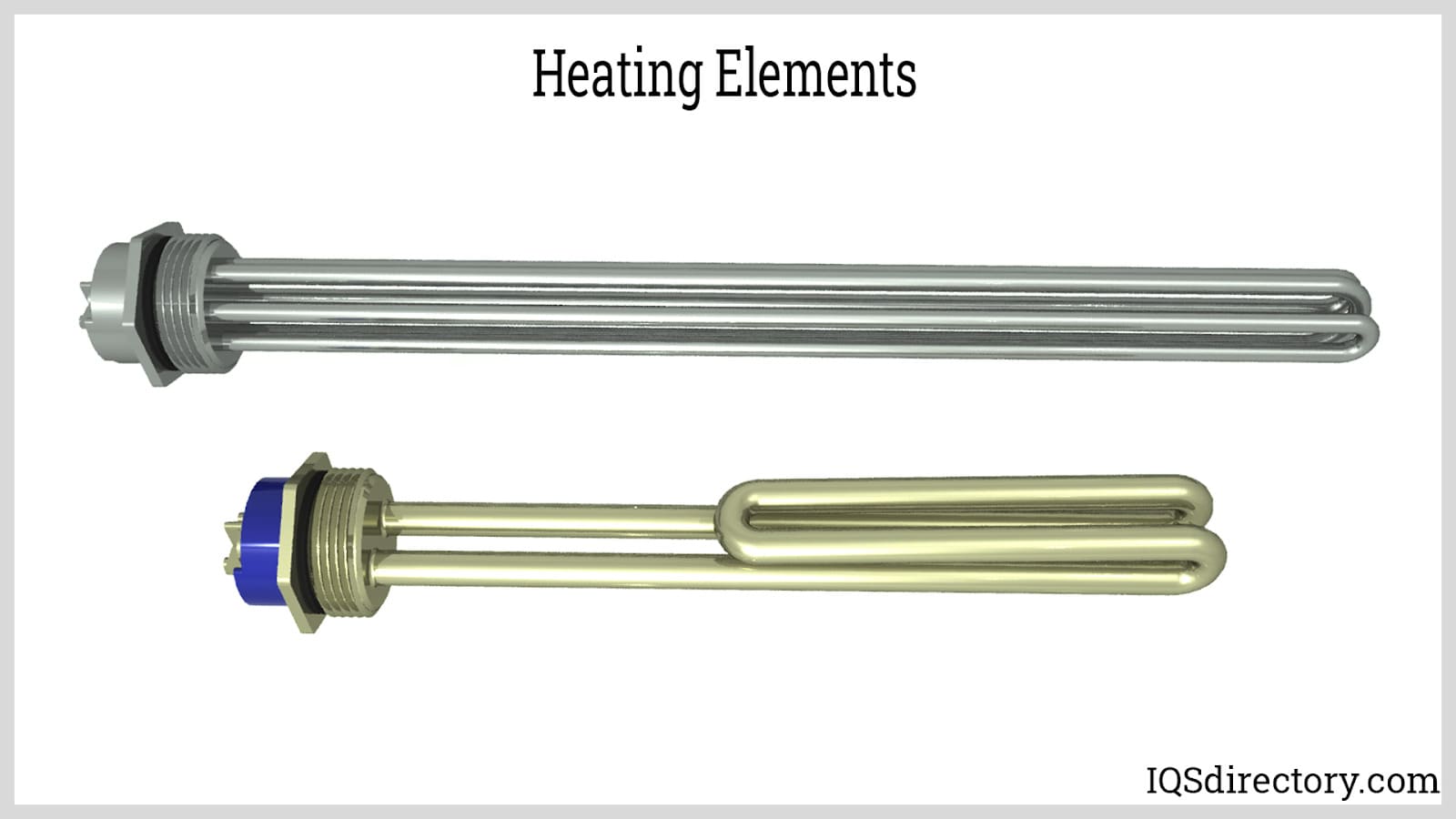
Chapter 1: What is a Heating Element?
A heating element is a material or device that directly converts electrical energy into heat or thermal energy through a principle known as Joule heating. Joule heating is the phenomenon where a conductor generates heat due to the flow of electric current. As the electric current flows through the material, electrons or other charge carriers collide with the ions or atoms of the conductor creating friction at an atomic scale. This friction then manifests as heat. Joule‘s first law (Joule-Lenz law) is used to describe the amount of heat produced from the flow of electricity in a conductor. This is expressed as,
P = IV or P =I²R
From these equations, the amount of heat generated depends upon the current and the voltage or the conductor resistance. In the design of heating elements, the resistance is the more important factor.
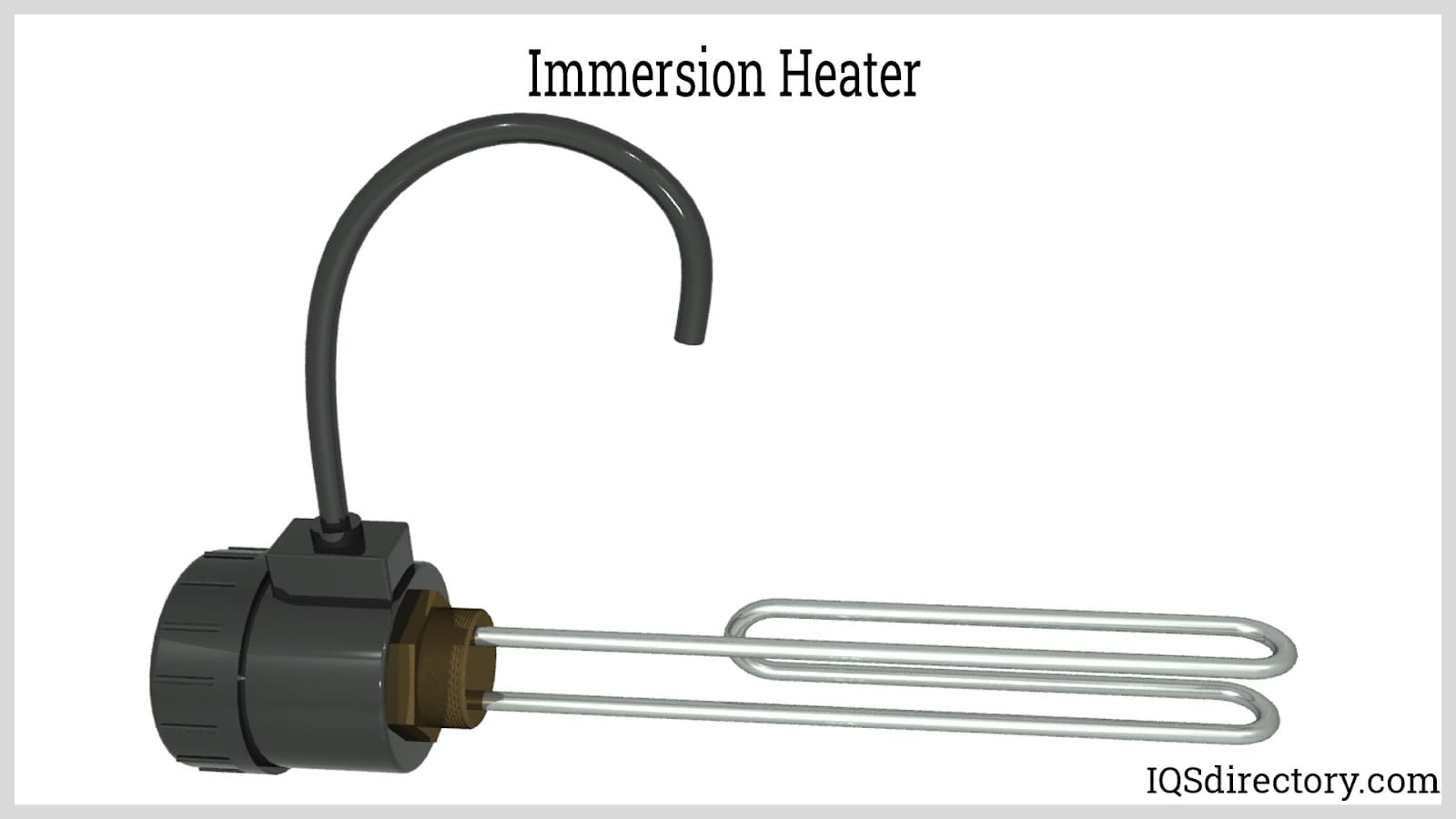
Joule heating is evident in all conducting materials in varying intensities, except for a special type of material known as superconductors. Generally, for electrically conductive materials, less heat is generated since the charge carriers can easily flow through; while for materials with high electric resistance, more heat is generated. Superconductors, on the other hand, allow the flow of electricity but do not produce any heat. Usually, heat from conductors is classified as energy loss. Electrical energy used to drive powered equipment generates unnecessary heating in the form of copper loss which ultimately does not produce any useful work.
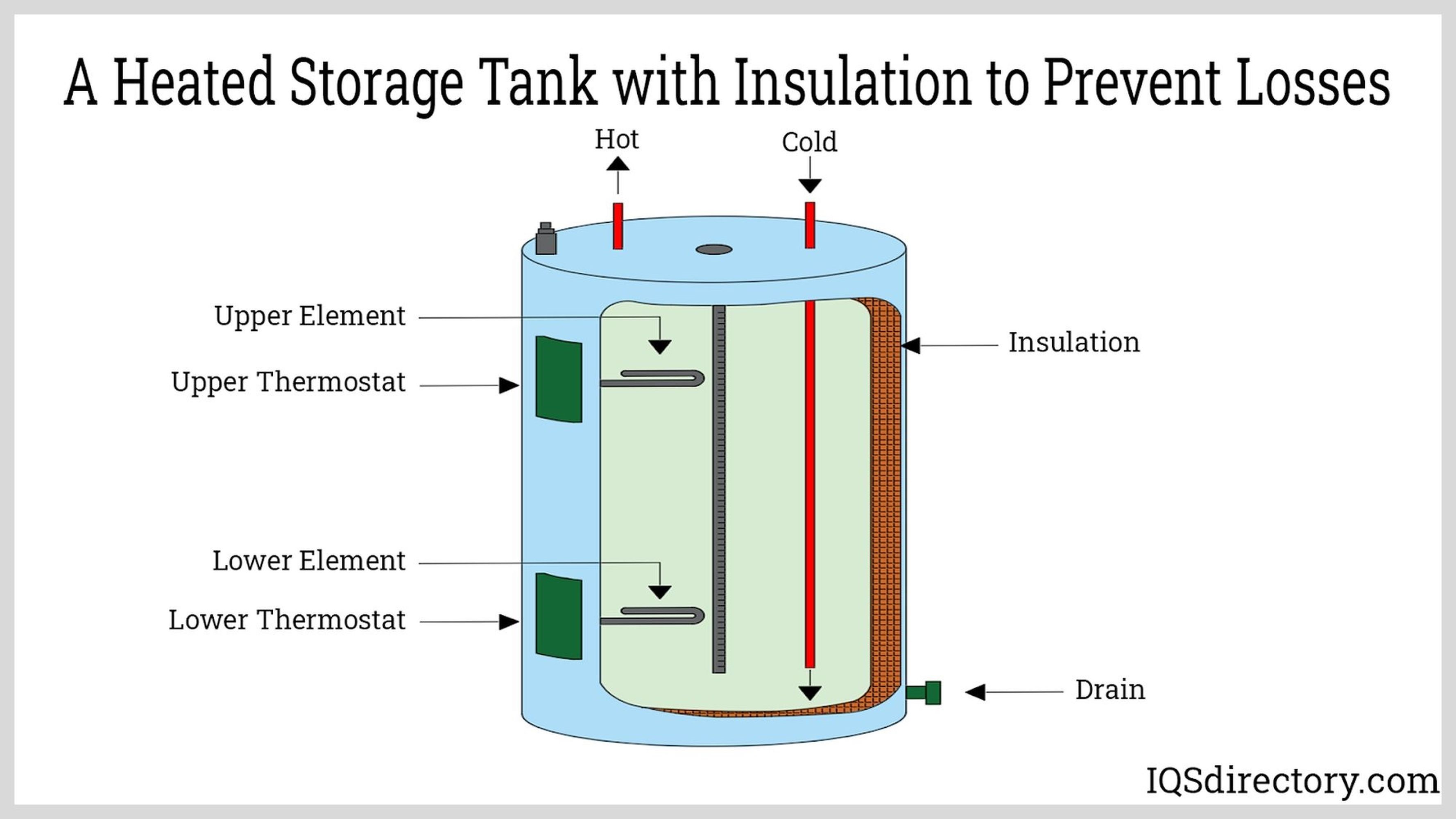
Electrical heating elements, in a sense, are almost 100% efficient since all supplied energy is converted into its intended form. Heating elements may not only conduct heat but also transfer energy through light and radiation as well. However, this is only true for ideal resistors. Small losses can be derived from the inherent capacitance and inductance of the material which converts the electrical energy into electric and magnetic fields, respectively. Considering the whole heater system, losses are from the dissipation of heat into the external environment from the process fluid or from the heater itself. Thus, the system must be isolated to utilize all the heat generated.
Chapter 2: Heating Element Properties
Almost all conductors are capable of generating heat when an electric current is passed through. However, not all conductors are suited to be made into heating elements. The right combination of electrical, mechanical, and chemical properties is required. Enumerated below are the properties significant to heating element design.
-
Resistivity: To produce heat, the heating element must have enough electrical resistance. However, the resistance must not be so high that it becomes an insulator. Electrical resistance is equal to the resistivity multiplied by the length of the conductor divided by the conductor cross-section. For a given cross-section, to have a shorter conductor, a material with a high resistivity is used.
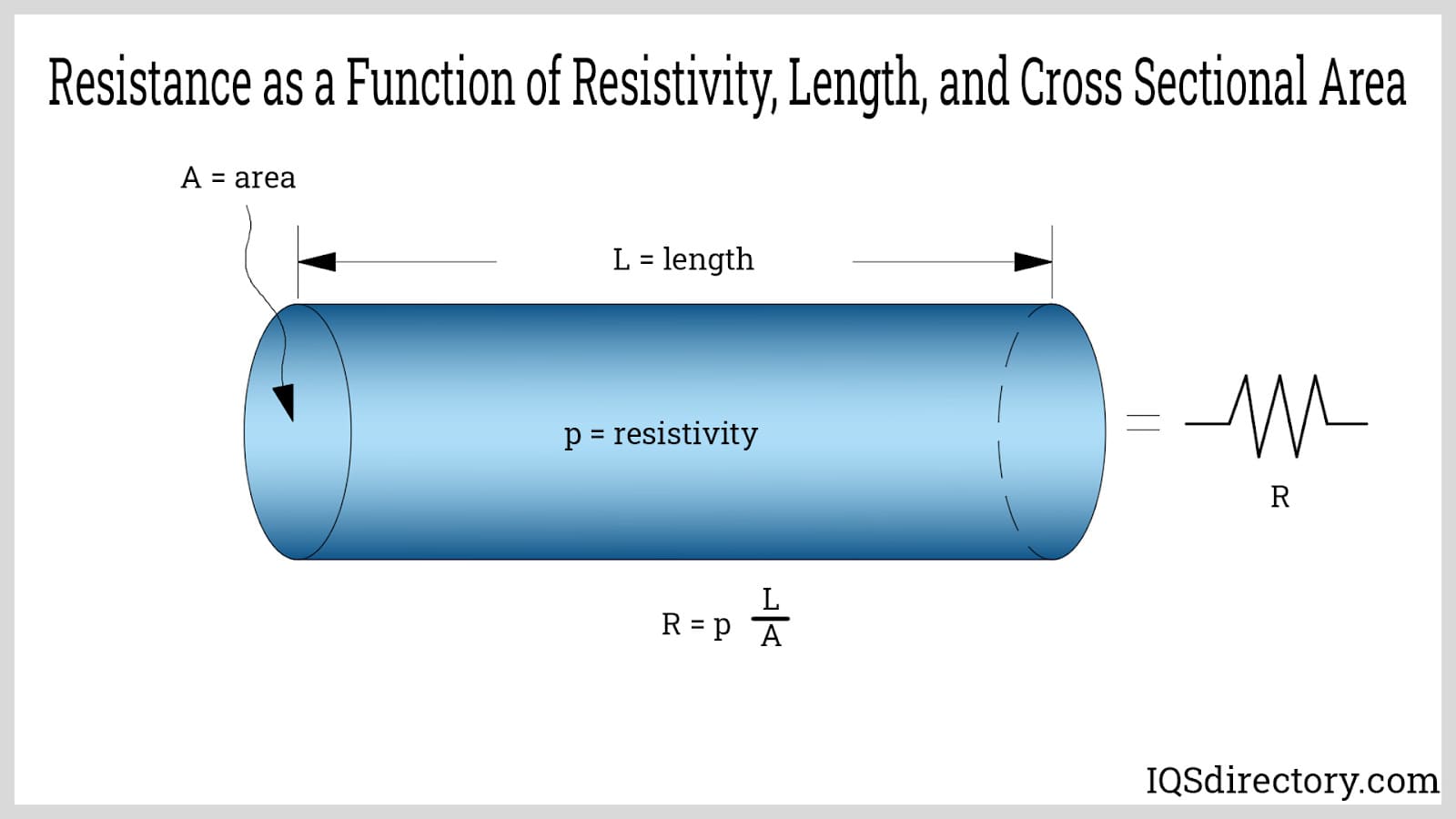
- Oxidation Resistance: Heat generally accelerates oxidation in both metals and ceramics. Oxidation can consume the heating element which can decrease its capacity or compromise its structure. This limits the life of the heating element. For metallic heating elements, alloying with an oxide former, helps in resisting oxidation by forming a passive layer. For ceramic heating elements, protective oxidation resistant scales of SiO2 or Al2O3 are most common. Heating element types not suitable for use in oxidizing environments, such as graphite, are most often used in vacuum furnaces, or furnaces containing non-oxidizing atmosphere gases, such as H2, N2, Ar or He, where the heating chamber is evacuated of air.
-
Temperature Coefficient of Resistance: Note that the resistivity of the material changes with temperature. In most conductors, as temperature increases, resistance also increases. This phenomenon has a more significant effect on some materials than others. A higher temperature coefficient of resistance is mostly used for heat-sensing applications. For heat generation, it is usually better to have a lower value. Though in some instances where the change in resistance can be accurately predicted, a sharp increase in resistance is desirable to deliver more power. To make the system adjust for the changing resistivity, control or feedback systems are employed.
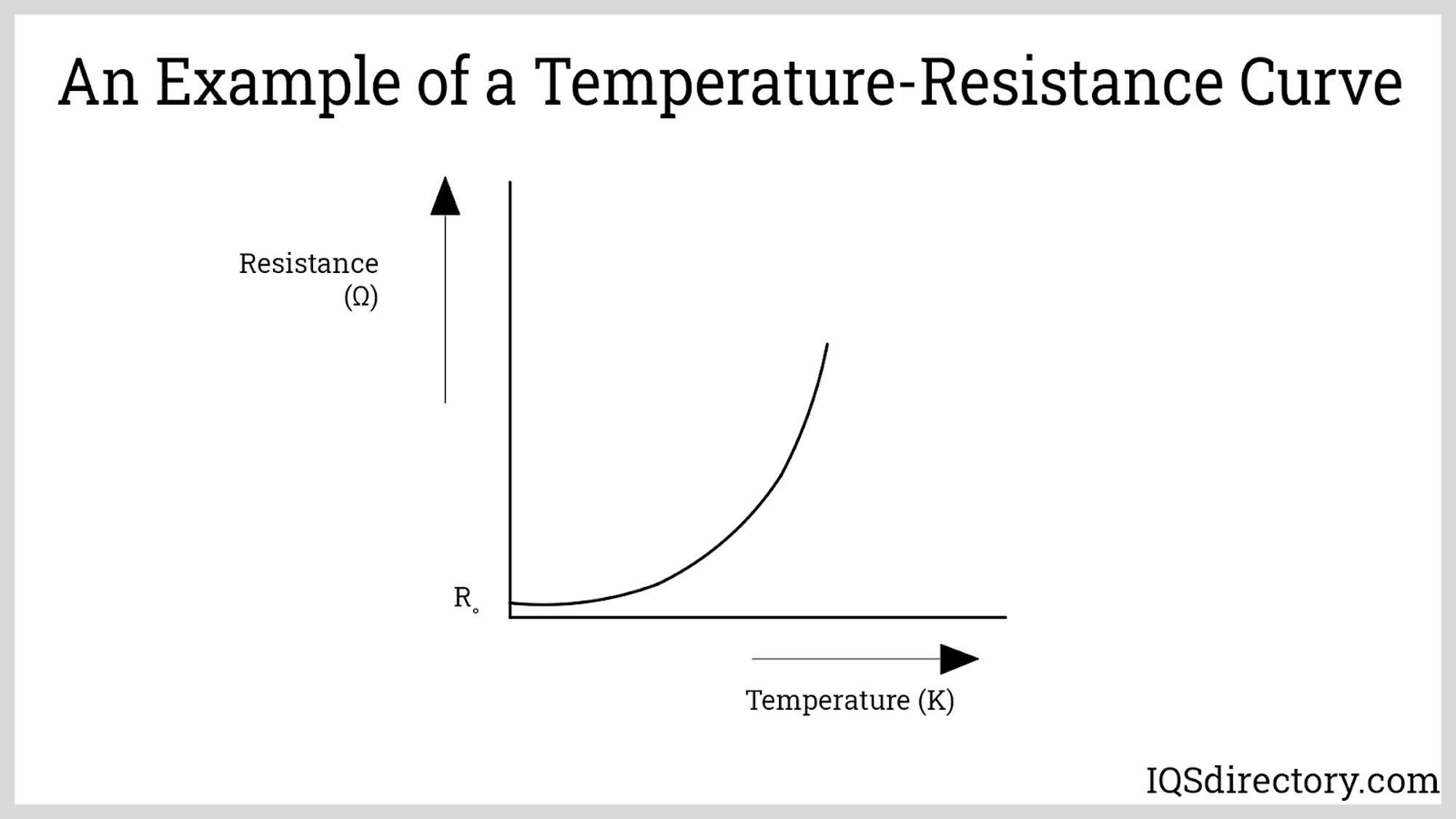
- Mechanical Properties: Rigid heating elements can deform when used at high temperatures. As the material approaches its molten or recrystallization phase, the material can weaken and deform more easily as compared to its state at room temperature. A good heating element can maintain its form even at high temperatures. On a different note, ductility is also a desired mechanical property, especially for metallic heating elements. Ductility enables the material to be drawn into wires and formed into shape without compromising its tensile strength.
- Melting Point: Aside from the temperature where oxidation significantly increases, the material‘s melting point also limits its operating temperature. Ceramics generally have higher melting points than metallic heaters.
Leading Manufacturers and Suppliers
GET YOUR COMPANY LISTED ABOVE
Chapter 3: Heating Element Materials
The material properties mentioned in the previous chapter narrows down the selection into a few materials. The most common materials are nickel-chromium alloy, iron-chromium-aluminum alloy, molybdenum silicide, and silicon carbide. These materials can operate at high temperatures due to their resistance to high-temperature oxidation. Another group is composed of graphite, molybdenum, tungsten, and tantalum. These materials oxidize at high temperatures and are only used in a vacuum environment or in furnaces where the atmosphere is devoid of oxygen.
Nickel-Chromium (Ni-Cr) Alloy
This type is one of the most widely used materials for heating elements due to its ductility, high resistivity, and oxidation resistance even at high temperatures. The most common composition of nickel-chromium alloys is 80/20 or 80% nickel, 20% chromium. Other compositions are available depending on the manufacturer. Due to its high ductility, it is usually drawn into wires when used as a heating element. A common application that exhibits this property is on hot-wire foam cutters. Maximum heating temperatures achieved by nickel-chromium wires are around 1,100 to 1,200°C.
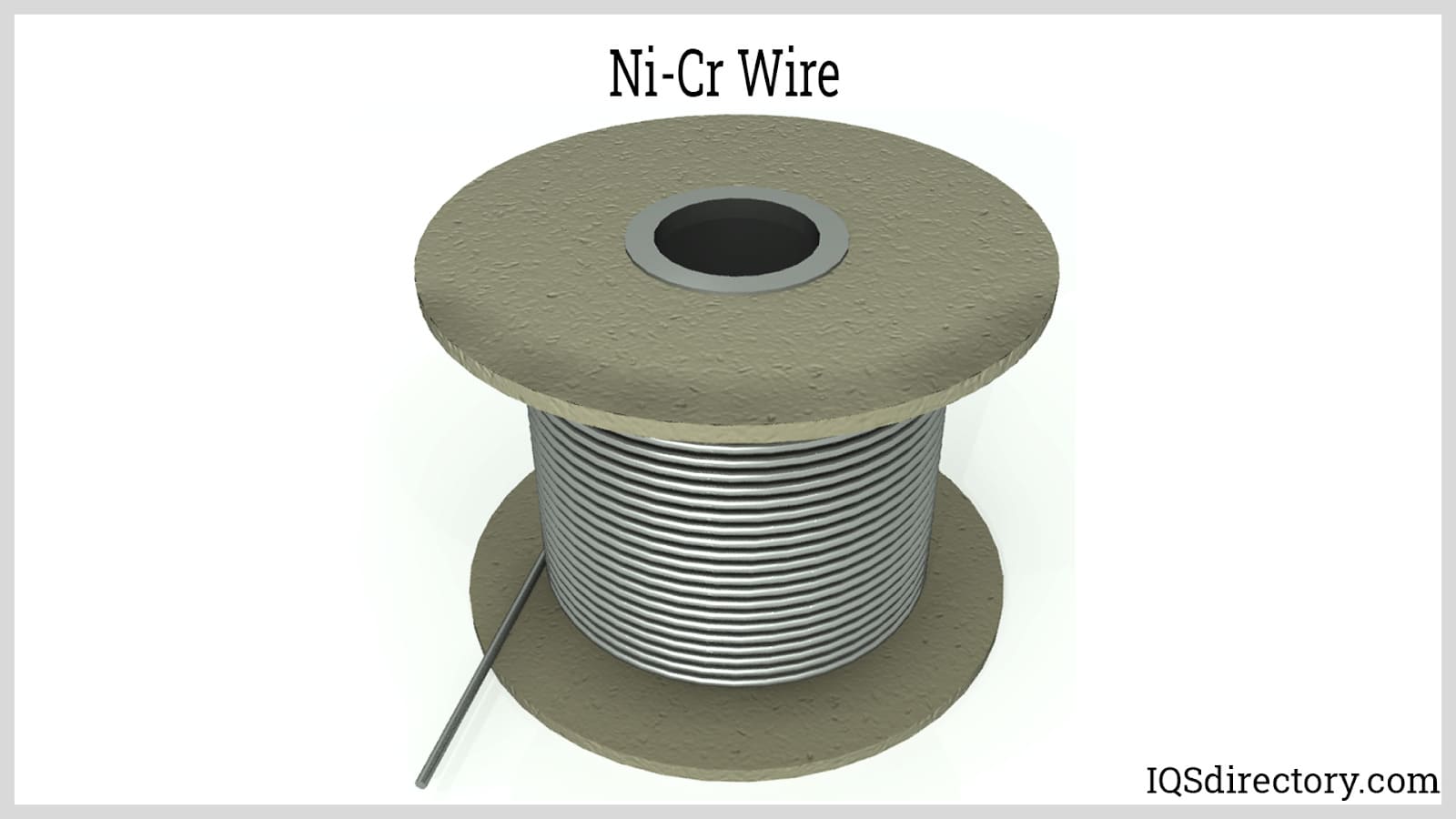
Iron-Chromium-Aluminum (Fe-Cr-Al) Alloy
This type is popularly known under the trademark Kanthal. Kanthal ferritic iron-chromium-aluminum alloys typically have a chemical composition of 20 to 24% chromium, 4-6% aluminum, and iron as the balance. Iron-chromium-aluminum heaters are used for their pliability and lower gravity compared to Ni-Cr. They can also generate higher temperatures than nickel-chromium wire, which is around 1,300 to 1,400°C. By having iron as the base metal, this alloy has less price volatility than Ni-Cr, which is composed mostly of nickel. The downside of using iron-chromium-aluminum alloys is their decreased strength at higher temperatures.
Iron-chromium-aluminum alloys may be made better by a process known as powder metallurgy. In this process, the alloy ingot is turned into powder and compressed into a die. It is then sintered or hot-pressed (hot isostatic pressing) in a temperature-controlled atmosphere to create a metallurgical bond without completely melting the powdered metal. Dispersoids are added into the alloy mix to reinforce the mechanical properties of the material to impart additional strength and toughness at higher temperatures.
Molybdenum Disilicide (MoSi2)
Molybdenum disilicide is a refractory cermet (ceramic-metallic composite) primarily used as a heating element material. This is a desirable material for high-temperature furnaces due to its high melting point and good corrosion resistance. Molybdenum silicide heating elements are produced by various energy-intensive processes such as mechanical alloying, combustion synthesis, shock synthesis, and hot isostatic pressing.
MoSi₂ type heaters can achieve heating temperatures up to 1,900°C. Downsides for using molybdenum silicide are its low toughness at ambient conditions and high-temperature creep. Its brittleness at room temperature necessitates very careful handling. Increased toughness is achieved at its brittle-ductile transition temperature around 1,000°C. A higher creep rate, on the other hand, causes the heating element to easily deform at high temperatures. The most common type of MoSi2 element is a 2-shank hairpin design, that is usually suspended through the roof of a furnace, and located around the furnace walls. Other shapes are available often combined with ceramic insulation formers that provide both mechanical support and thermal insulation as an integrated package.
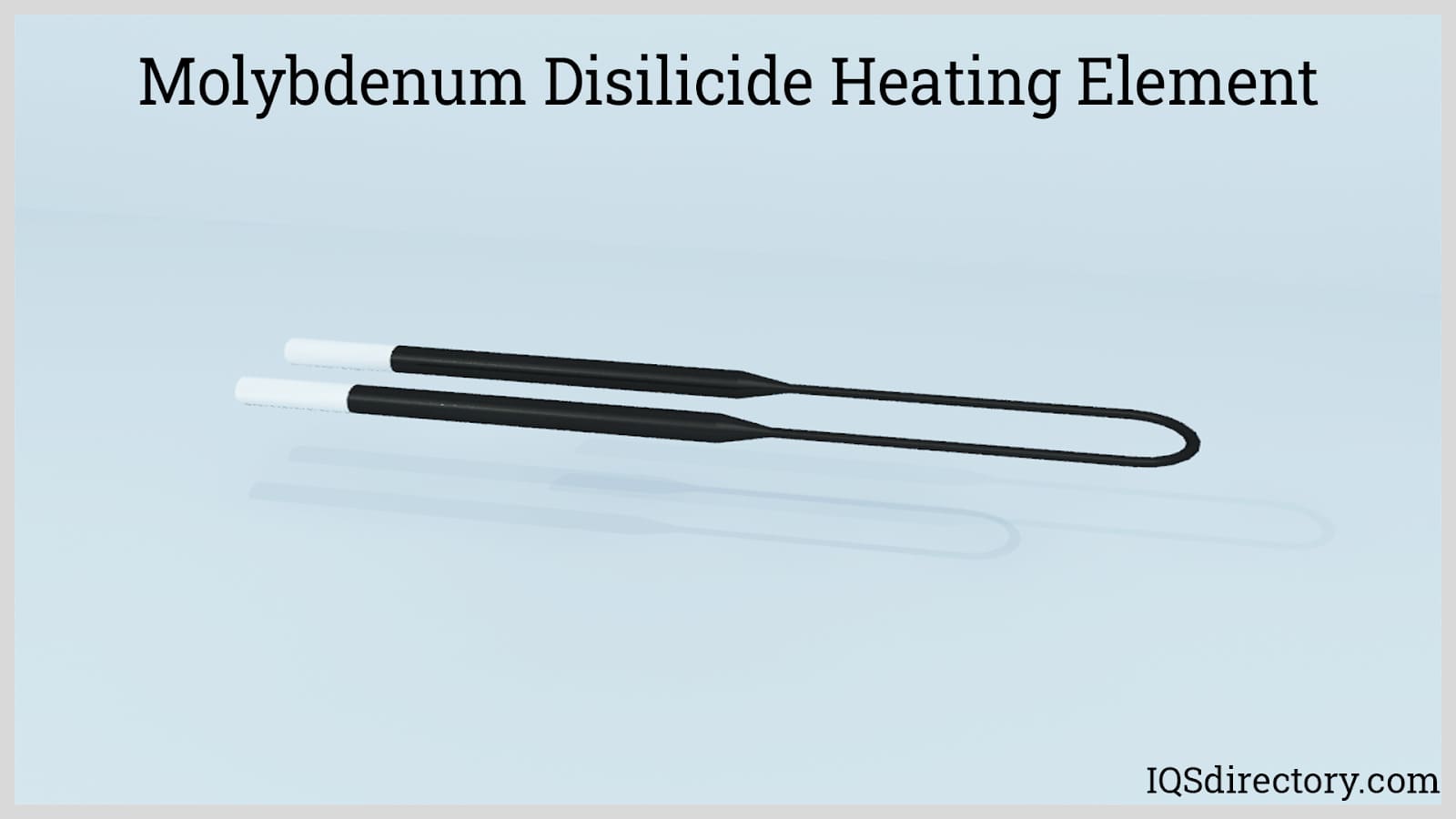
Silicon Carbide (SiC)
This is a type of ceramic produced by recrystallization or reaction bonding of SiC grains at temperatures above 2,100°C. Silicon carbide heating elements are porous bodies (typically 8-25%) where the furnace atmosphere can react through the cross-section of the material. The whole heating element may be gradually oxidized which leads to an increase in the electrical resistance properties of the elements over time (commonly referred to as “aging”) A variable voltage supply is usually required to maintain the desired power output from the elements by gradually increasing the voltage to the elements during their lifetime. This aging eventually limits the life and performance of the heating element.
Silicon carbide has many properties that make it suitable for making heating elements for very high service temperatures. This ceramic has no liquid phase. Meaning that elements will not sag or deform due to creep at any temperature, and no supports are required inside the furnace. SiC directly sublimates at temperatures around 2,700°C. Moreover, it is chemically inert from most process fluids and has high rigidity and a low coefficient of thermal expansion. Silicon carbide heaters can achieve around 1,600 to 1,700°C heating temperatures.
Graphite
Graphite is a mineral composed of carbon wherein the atoms are arranged in a hexagonal structure. This mineral, also its synthetic form, is a good thermal and electric conductor. Graphite can generate heat at temperatures greater than 2,000°C. At high temperatures, its electric resistance significantly increases. Moreover, it can withstand thermal shocks and does not become brittle even after rapid cycles of heating and cooling. The main disadvantage of using graphite is its tendency to oxidize at temperatures around 500°C. Continued use at this range eventually results in the consumption of the material. Graphite heating elements are typically used in vacuum furnaces where oxygen and other gases are evacuated from the heating chamber. The absence of oxygen not only prevents oxidation of the molten metals, but also the heating element itself.

Molybdenum, Tungsten, and Tantalum
These are refractory metals with similar properties as graphite when used as heating elements. Among these metals, tungsten has the highest operating temperature but also more expensive. In terms of viability, molybdenum is more popular since it is the least expensive but is still more expensive than graphite. Like graphite, they can only be used in vacuum conditions since they have a strong bonding affinity with oxygen and even hydrogen and nitrogen. They begin to oxidize at temperatures around 300 to 500°C.
Positive Thermal Coefficient (PTC) Materials
Typical PTC material is rubber but can be ceramics as well. PTC rubber is made of polydimethylsiloxane (PDMS) with carbon nanoparticles. PTC heaters have a unique property in which the heater maintains or limits the current flow by having an increased electrical resistance as the temperature increases. This makes the material safe and suitable for use in clothing. Initially, the heater draws full power and heats up due to its resistivity. The material‘s resistance increases with the rising heat and then acts as an insulator. This is achieved without the need for any feedback loop.
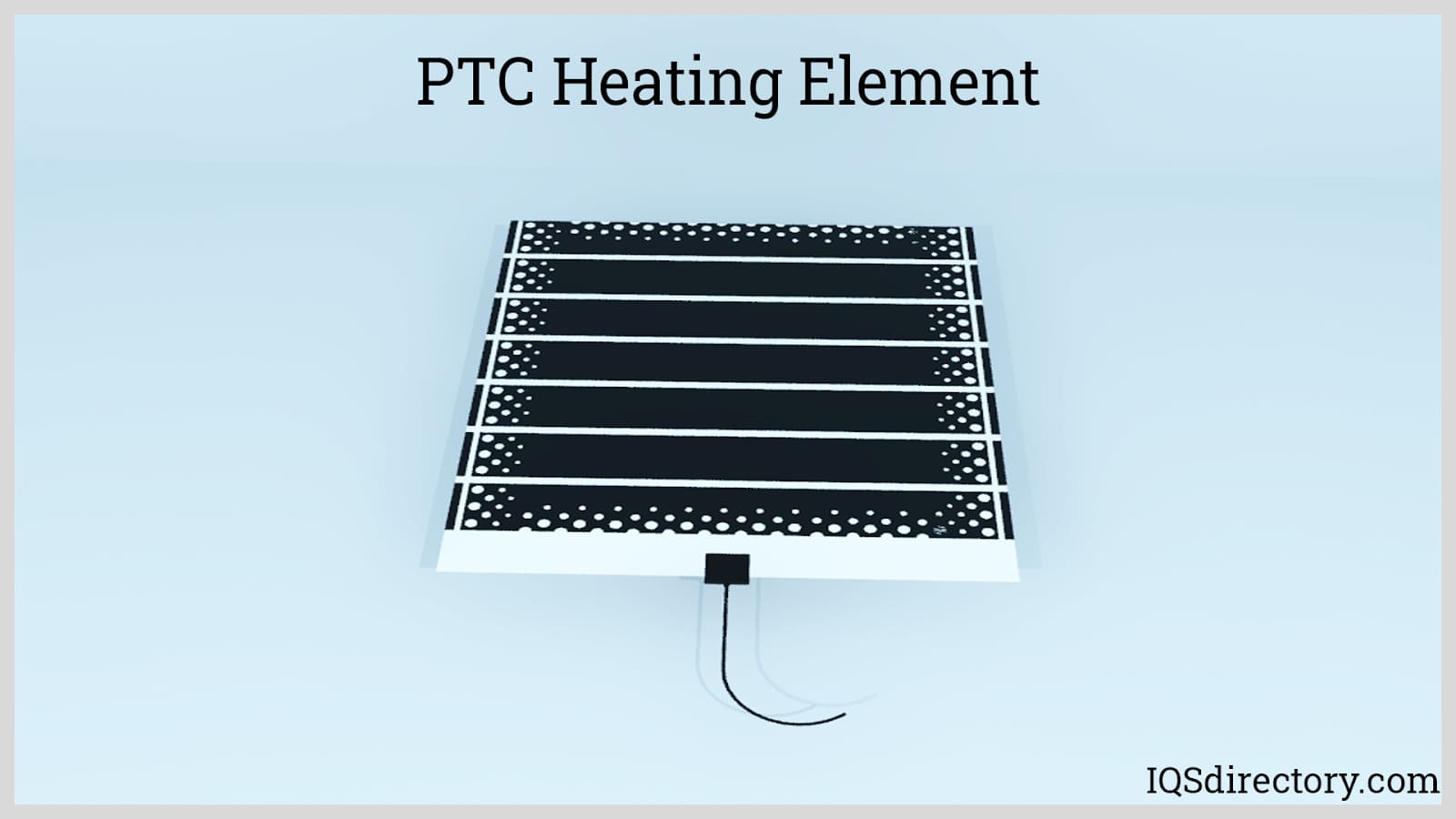
Chapter 4: Types of Heating Elements
The heating element alone does not comprise the entire heating system. Aside from the heating element, a heater consists of the terminations, leads, insulation, packing, sheath, and seals. These heaters have various forms and configurations to suit a particular application. Enumerated below are the most common heaters and their applications.
-
Air Process Heaters: As the name suggests, this type of heater is used to heat up flowing air. Air process heaters are basically a heated tube or pipe wherein one end is for introducing cold air while the other end is the hot air exit. Along the walls of the pipe are coils of heating elements insulated by ceramics and non-conducting gaskets. These are typically used in high-flow, low-pressure applications. Applications for air process heaters are heat shrinking, laminating, adhesive activation or curing, drying, baking, etc.
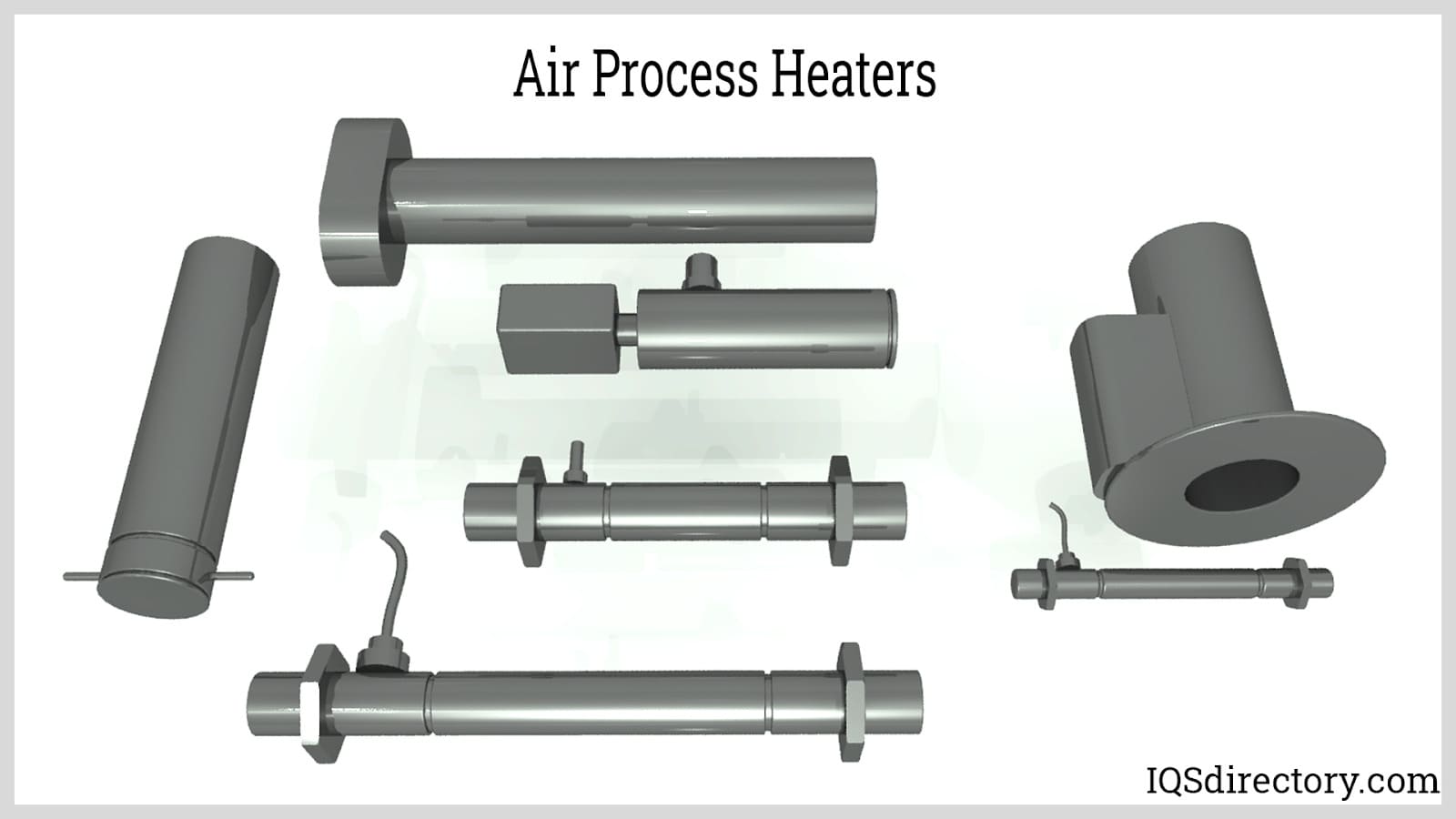
-
Cartridge Heaters: In this type of heater, the resistance wire is coiled around a ceramic core, typically made of compacted magnesium oxide. Rectangular configurations are also available where the resistance wire coils pass three to five times along the length of the cartridge. The resistance wire or the heating element is situated near the walls of the sheathing material for maximum heat transfer. To protect the internals, the sheath is usually made of corrosion resistant materials like stainless steel. The leads are usually flexible with both of their terminations located on one end of the cartridge. Cartridge heaters are used in die or mold heating, fluid heating (immersion heaters), and surface heating.
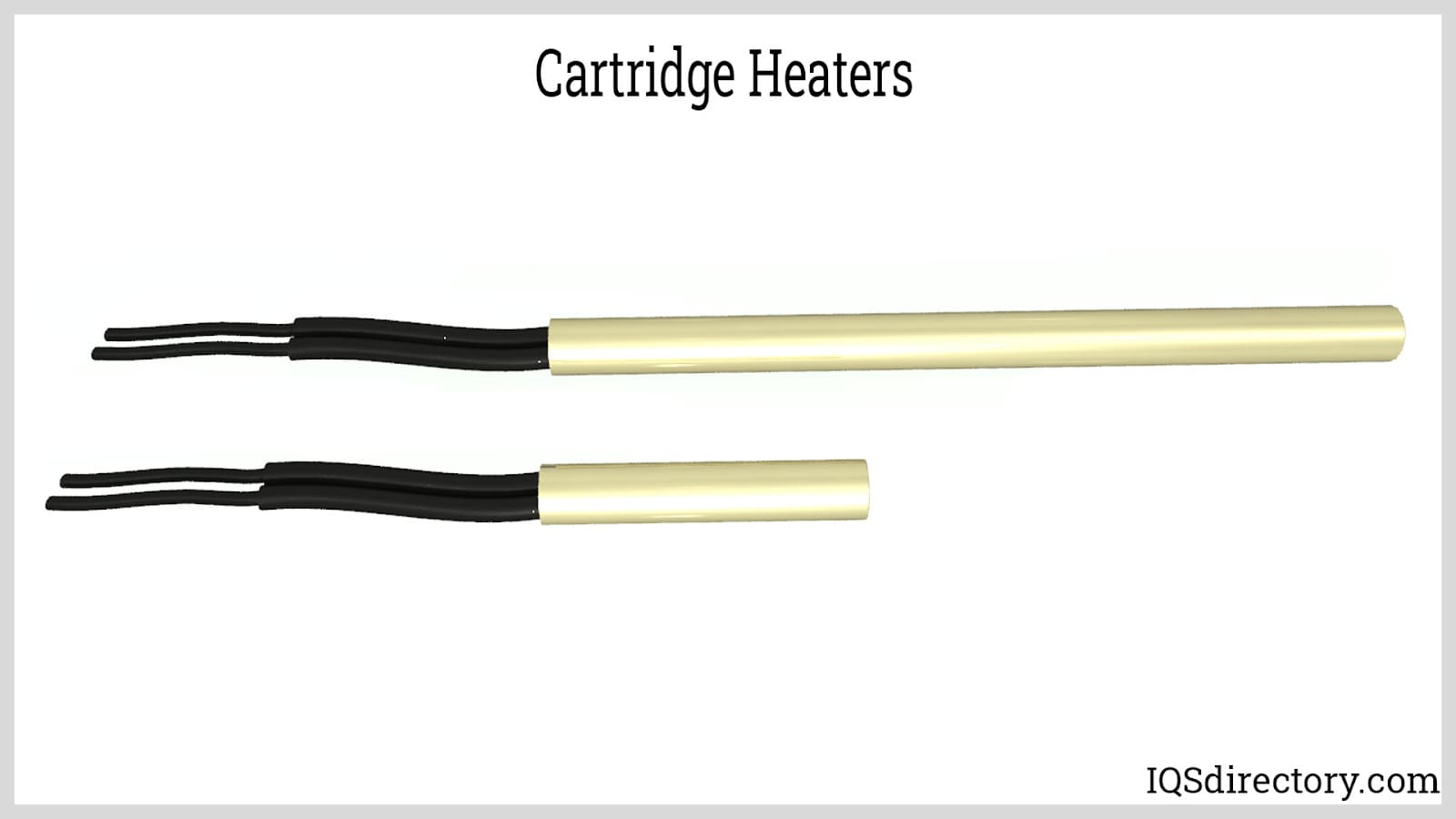
-
Tubular Heaters: Tubular heaters‘ internals is the same as that of cartridge heaters. Its main difference from cartridge heaters is that the lead terminals are on the opposite ends of the tube. The whole tubular construction can be bent into different forms to suit the heat distribution required by the space or surface to be heated. Also, these heaters can feature fins that are mechanically bonded onto the sheath surface to aid in an effective heat transfer. Tubular heaters are as versatile as cartridge heaters and are used in similar applications.
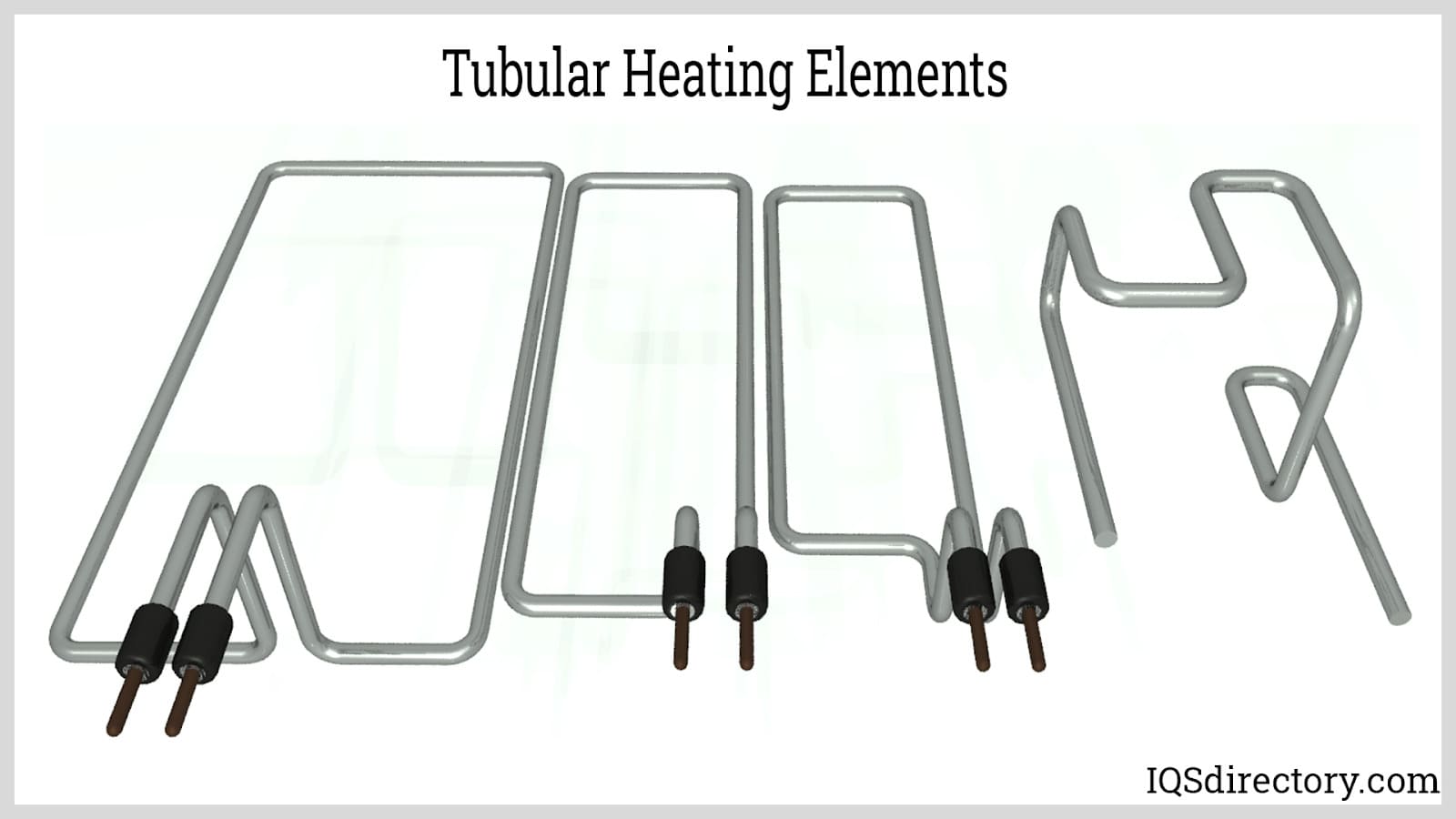
-
Band Heaters: These heaters are designed to wrap around cylindrical metal surfaces or containers such as pipes, barrels, drums, extruders, and so forth. They feature bolted locking tabs to securely clamp onto the surface of the container. Inside the band, the heater is a thin resistance wire or ribbon typically insulated by a mica layer. The sheathing is made of stainless steel or brass. Another advantage of using band heaters is that it indirectly heats the fluid inside the vessel. This means the heater is not subjected to any chemical attack from the process fluid. Possible ignition is also prevented when used for oil and lubricant service.
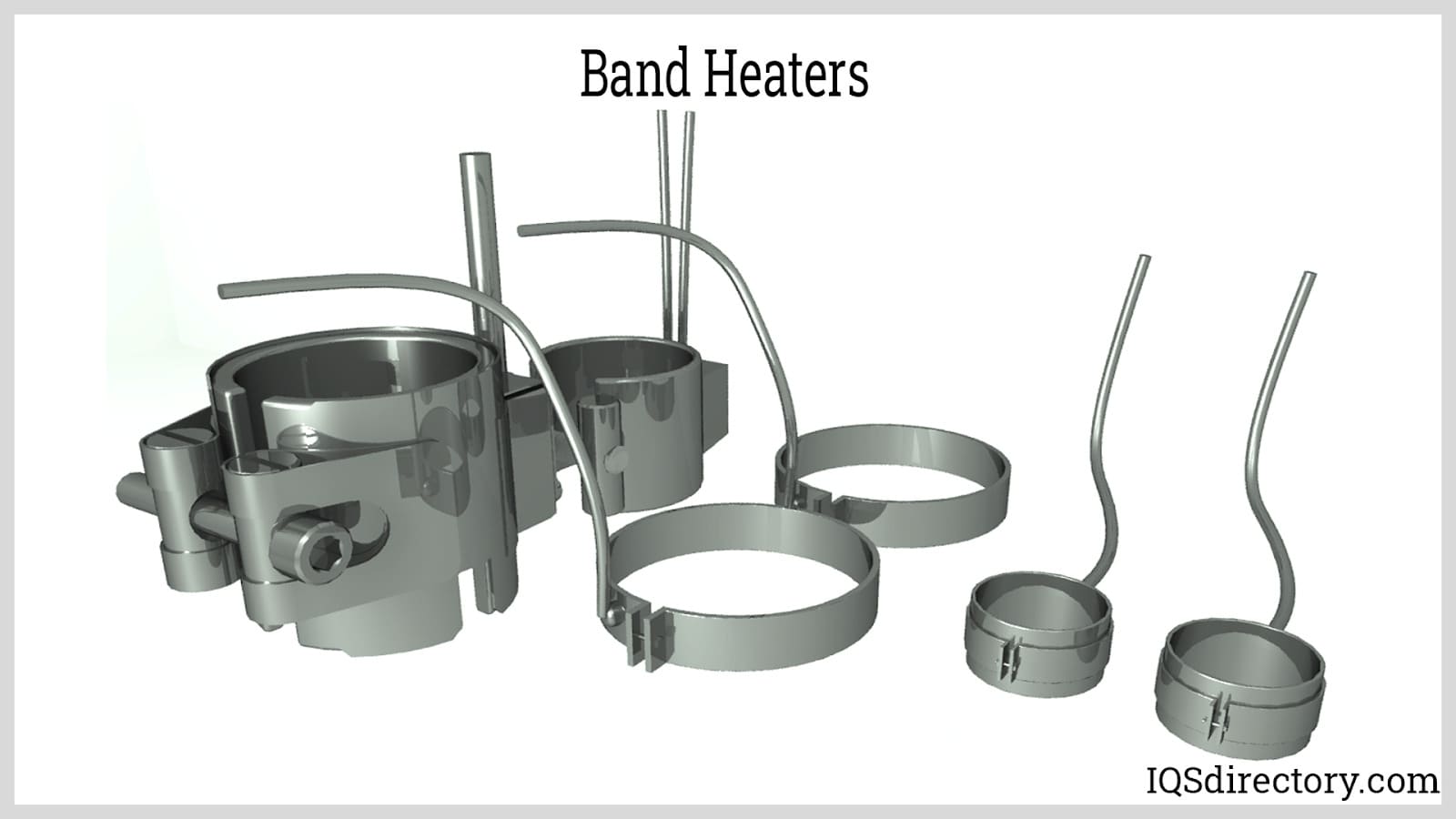
-
Strip Heaters: This type of heater is flat and rectangular in form and is bolted on to the surface to be heated. Its internals are similar to a band heater. However, the insulating material, aside from mica, can be ceramics such as magnesium oxide and fiberglass. The typical use of strip heaters is surface heating of dies, molds, platens, tanks, ducts, etc. Aside from surface heating, they can also be used for air or fluid heating by having finned surfaces. Finned strip heaters are seen in ovens and space heaters.
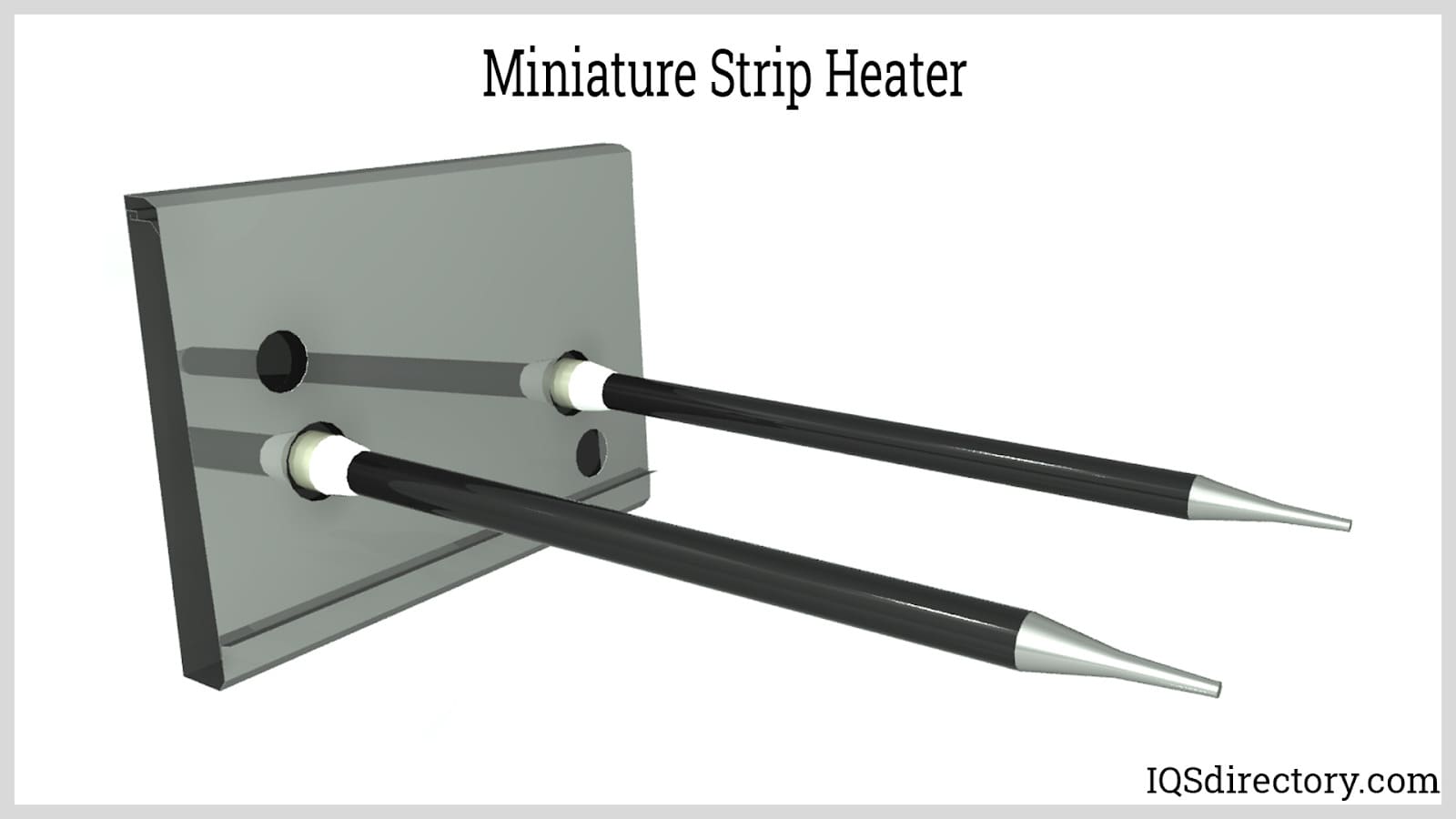
-
Etched Foil Heaters: Etched foil heaters can also be referred to as thin-film heaters. In this type, the resistive heating material is etched and bonded onto a foil usually made of aluminum. If more flexibility and tear resistance is required, the substrate can also be made of heat-resisting synthetic rubber or thermoplastic polyurethane (TPU). In addition to its flexibility, another advantage is the tight spacing of the heating elements. This is the inherent advantage of photochemical etching. Even heat distribution with a larger heat density can be achieved in such small forms. Its applications are more specialized in comparison with the conventional wire heaters. Etched foil heaters are usually seen in medical devices, electronics and instrumentation, aerospace, and clothing. One side can be lined with an adhesive layer for easy mounting.
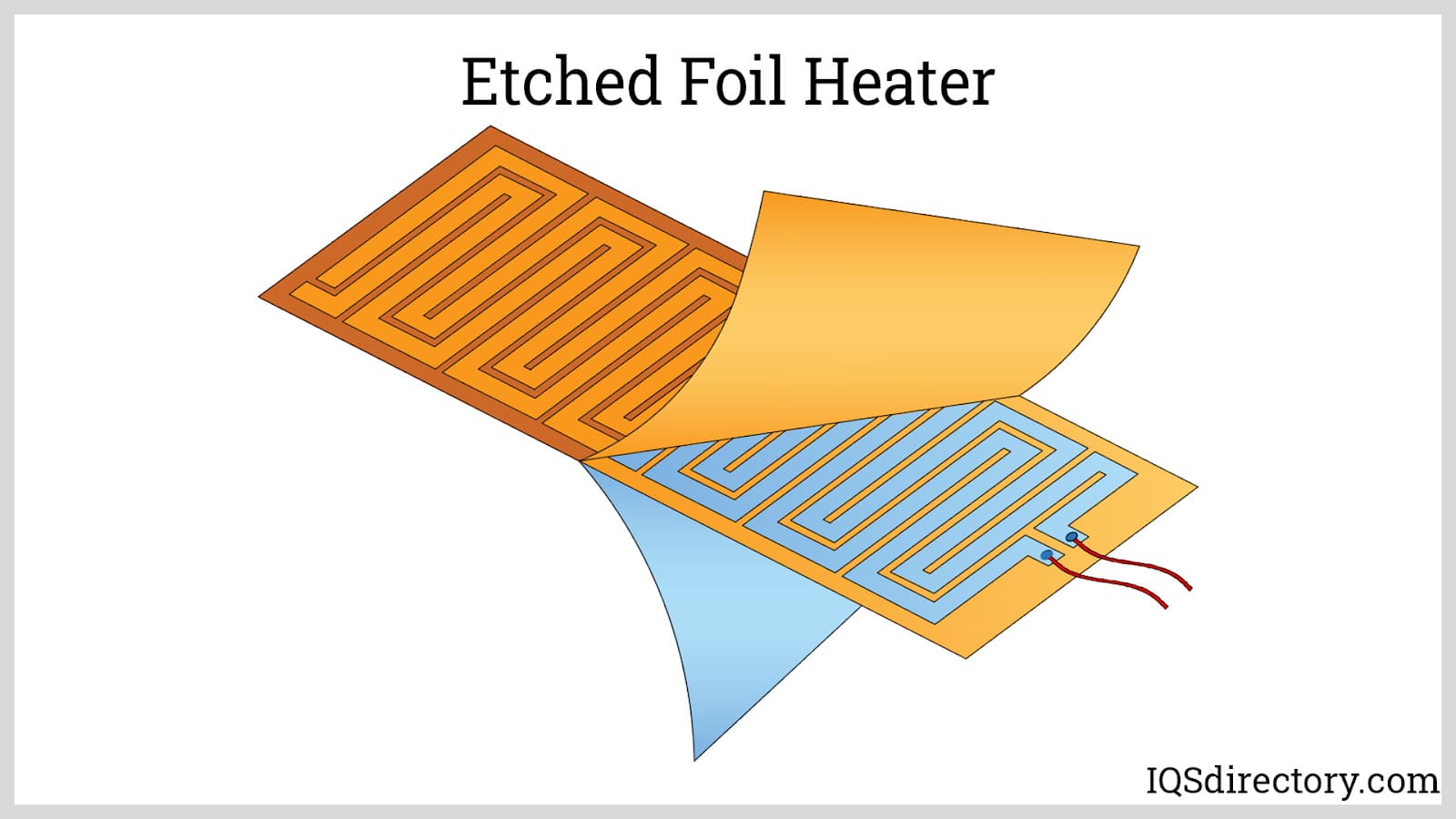
-
Ceramic Heaters: These heaters use ceramics with a high melting point, high thermal stability, high-temperature strength, high relative chemical inertness, and small heat capacity. Note that these are different from ceramics used as an insulating material. Due to its good thermal conducting properties, it is used to conduct and distribute heat from the heating element. Notable ceramic heaters are silicon nitride and aluminum nitride. These are commonly used for rapid heating as seen on glow plugs and igniters. However, when subjected to quick high-temperature heating and cooling cycles, the material is prone to cracking due to fatigue caused by thermal stresses. A special type of ceramic heaters is a PTC ceramic. This type can self-regulate its power consumption which then prevents it from becoming red hot.
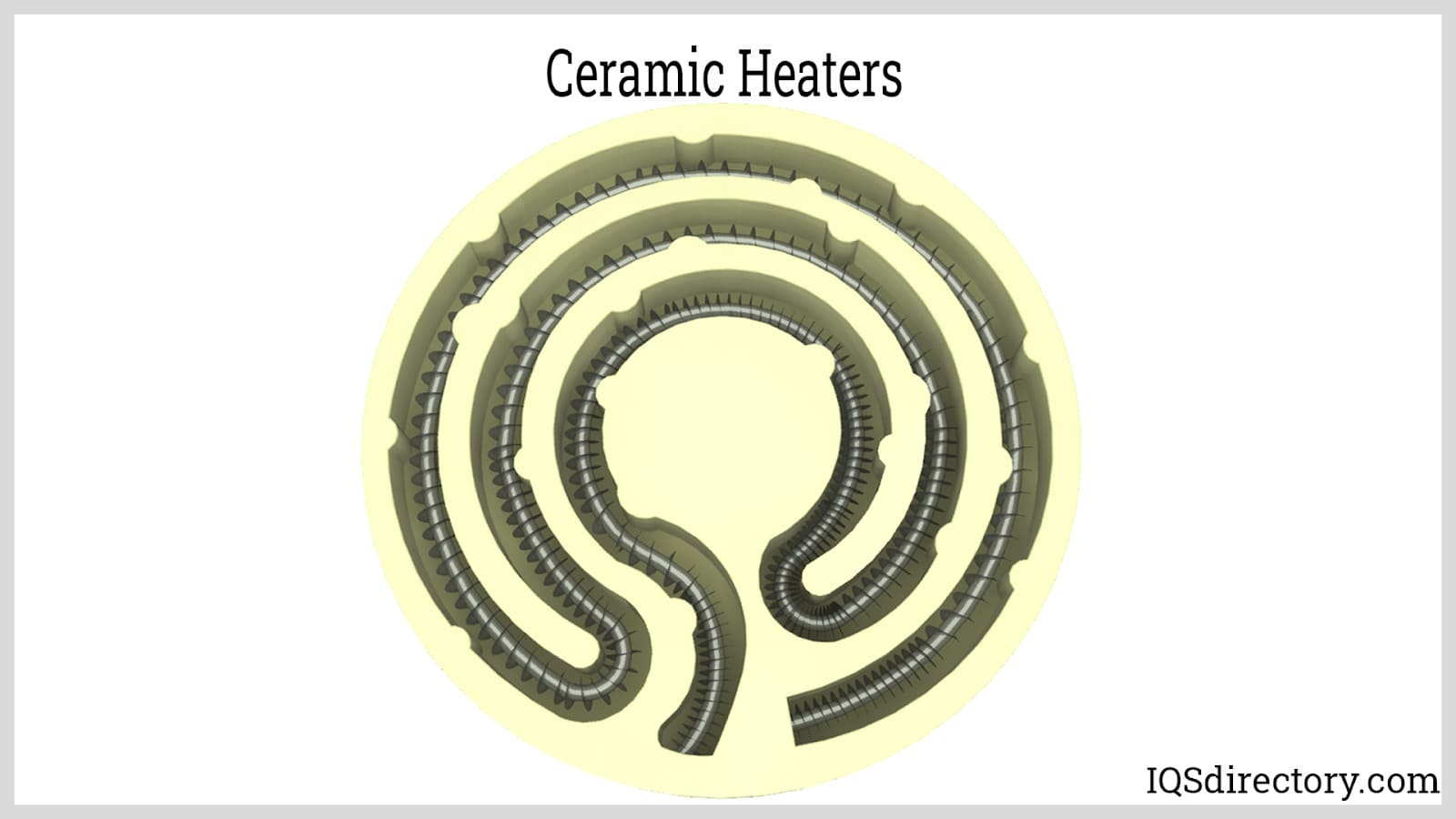
-
Ceramic Fiber Heaters: In this type of heater, the ceramic fiber is used as an insulator to concentrate the heat into the surface to be heated to prevent system losses. Ceramic fiber pads have a resistance wire wound on one-side. This side is bonded on the surface to be heated which can reach up to 1,200°C.
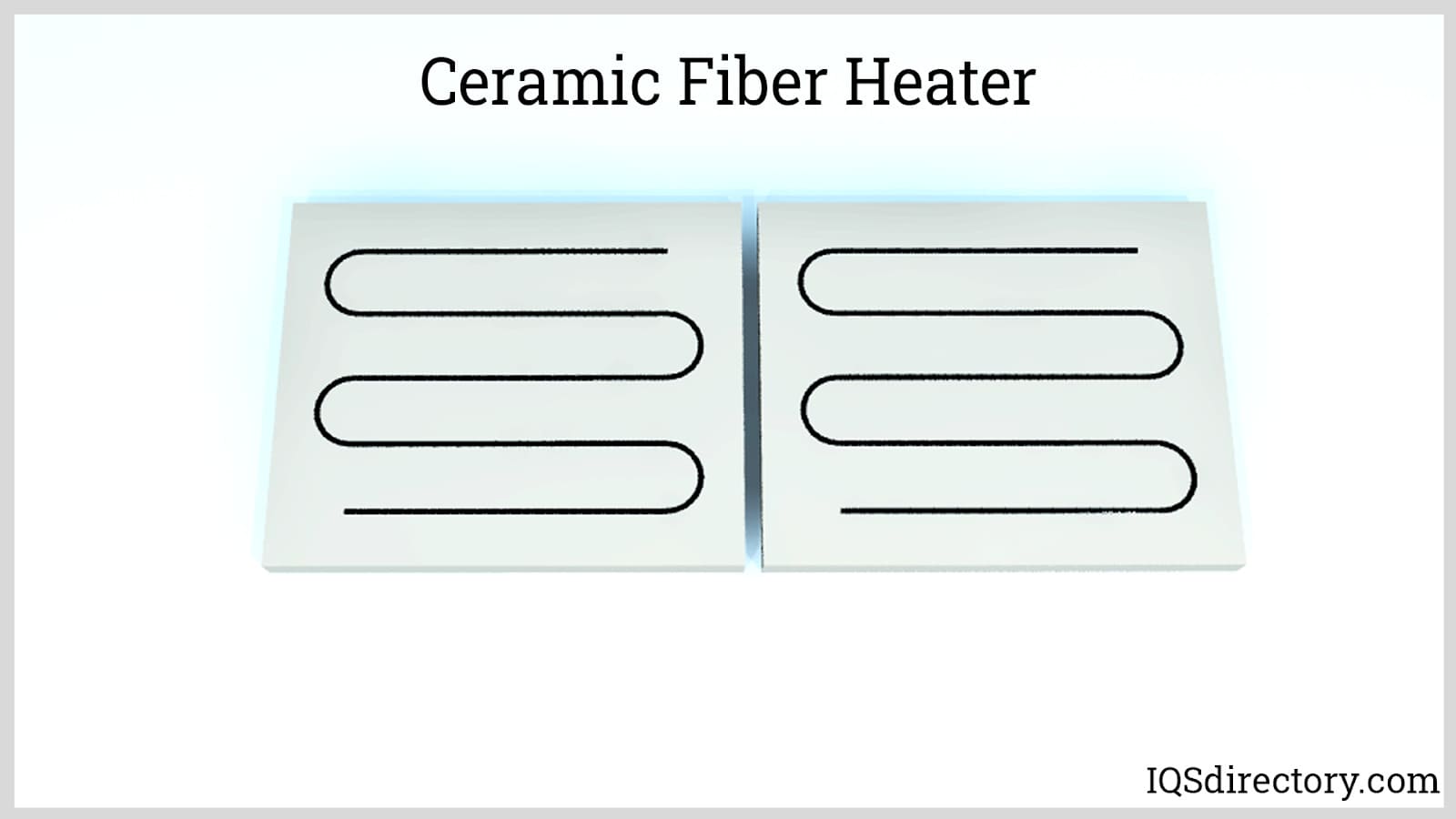
Chapter 5: Factors to Consider in Selecting a Heater
Heating elements technically operate the same way but several factors determine its performance and service life. Typical heater ordering specifications are the power or wattage, maximum operating temperature, type of process fluid, sheath material, and power supply (voltage and frequency). However, there are additional factors that need to be considered such as fluid flow and temperature control.
-
Watt Density: Watt density is the heat delivered of a heating element per unit area. The right watt density must be used for a specific application to fully utilize the service life of the heater. Note that for a given wattage, both high and low-density heaters will deliver the same amount of heat but at different temperatures. High-density elements can reach much higher temperatures which leads to premature burning or failure of the element. In selecting a heating element, check the manufacturer’s recommended watt densities for a particular application.
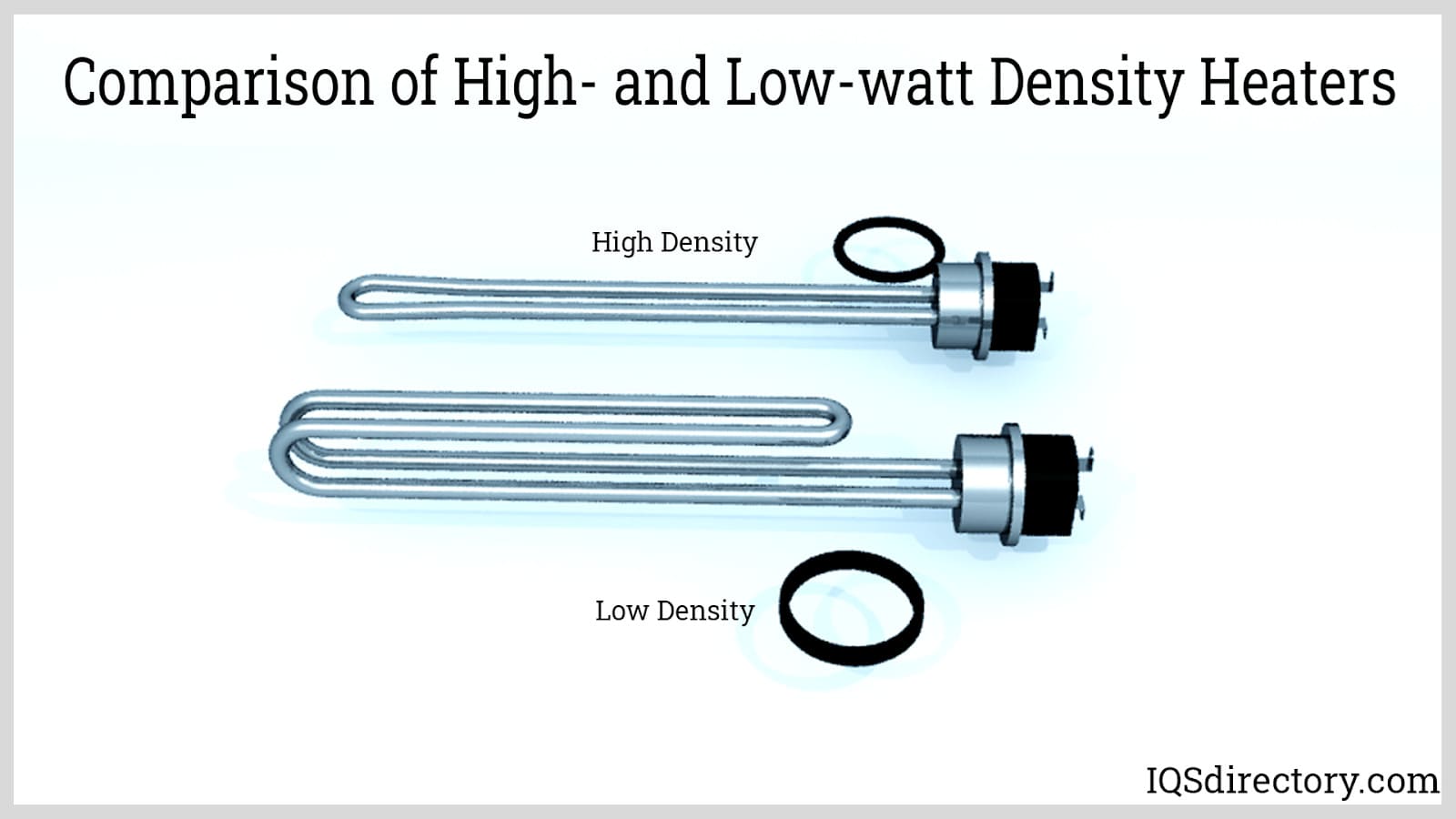
- Temperature: The target operating temperature directly affects the watt density. There must be a balance between these two factors. In designing a process heater, the temperature is determined first which is usually a process parameter required by the system.
- Power Supply: The heating element must be able to operate with the available power supply. Check the voltage rating which is typically 120V or 240V. In selecting a target wattage, verify the amperage produced. Be careful not to exceed the power supply circuit breaker tripping point or the ratings of the power cables.
-
Fluid Flow: From intuition, stagnant fluids are easier to heat with a controlled temperature than flowing fluids. Air or other gases do not generally absorb heat quickly because of their low density. A solution would be to slow down the flow, but most of the time, this is not an option. Thus, heaters with large surface areas are required. Finned surfaces and long wire coils (low-density heating elements) are the usual features of air heaters.
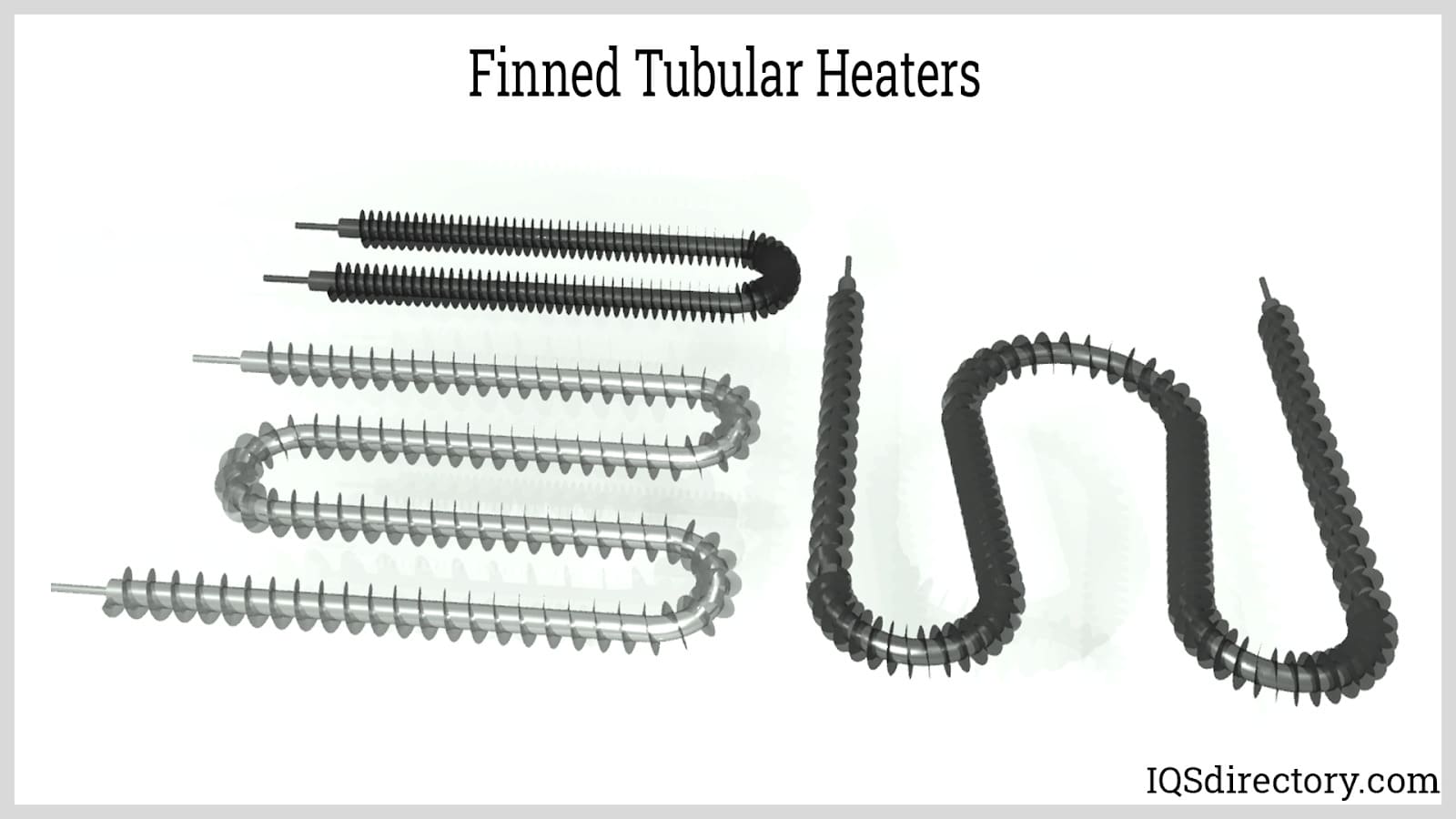
-
Temperature Sensor Location: Conventional heaters come with a temperature sensor and a controller. In most applications, the sensing device only measures the temperature of the process fluid. Note that this does not usually represent the actual heating element temperature. Before installing the heater and the temperature sensing device, check if its location is appropriate for the heater unit. If the sensor is too far, the temperature reflected may be much lower due to heat dissipation and low heat transfer rate. This can lead to very high temperatures that can burn the heating element.
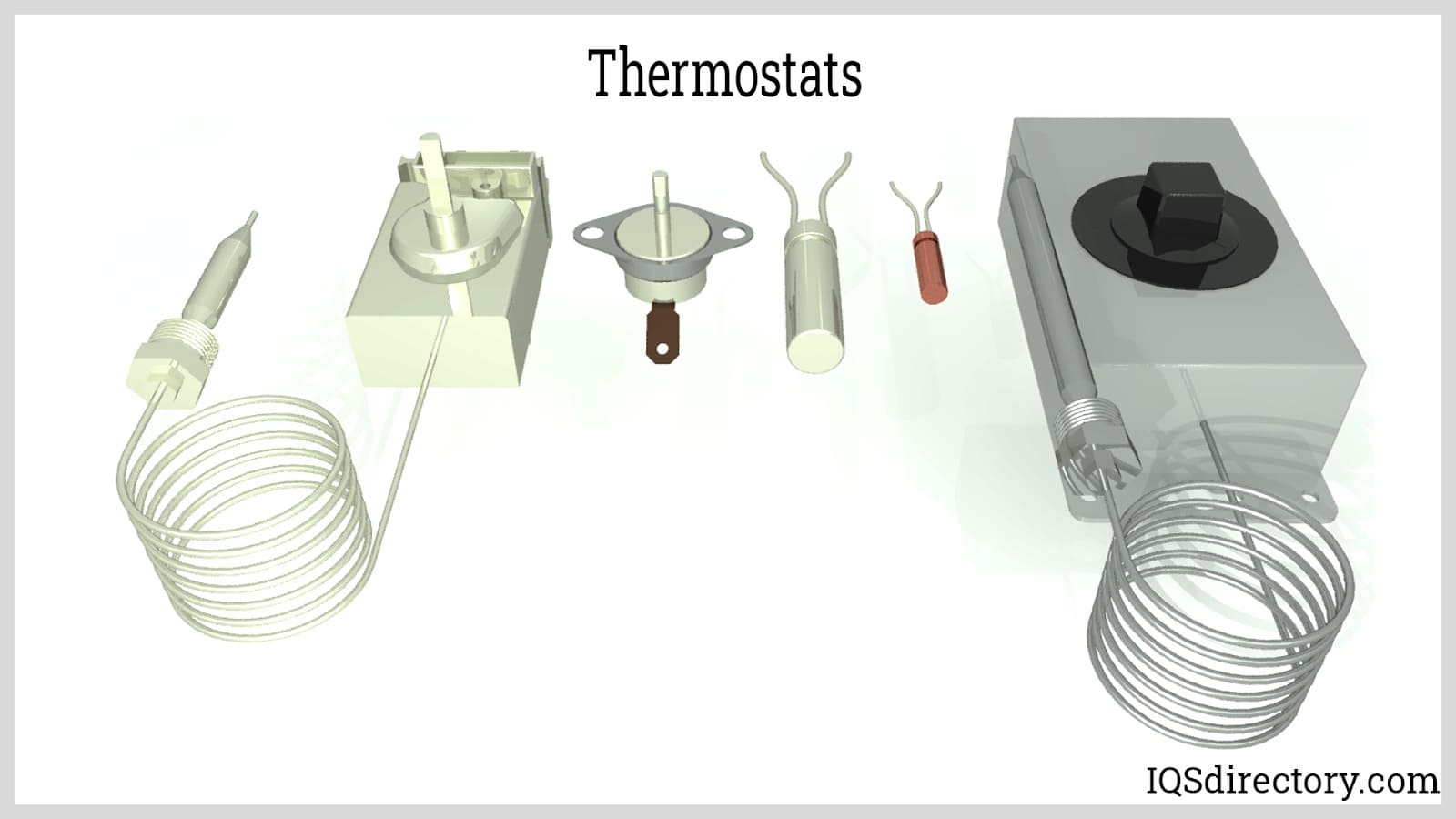
-
Corrosion: Corrosion can be from the process fluid or the external environment. The sheathing material protects the heating element, leads, and insulators from chemical attack. Thus, the sheath must be able to maintain its strength in high temperatures while being resistant to corrosion. Widely used sheathing materials are stainless steel, brass, copper, and other special alloys such as Monel and Incoloy. Moreover, the integrity of the sheath and terminal sealing must be sufficient for the application. For demanding applications, hermetic sealing is the best option in providing complete protection from the process fluid.
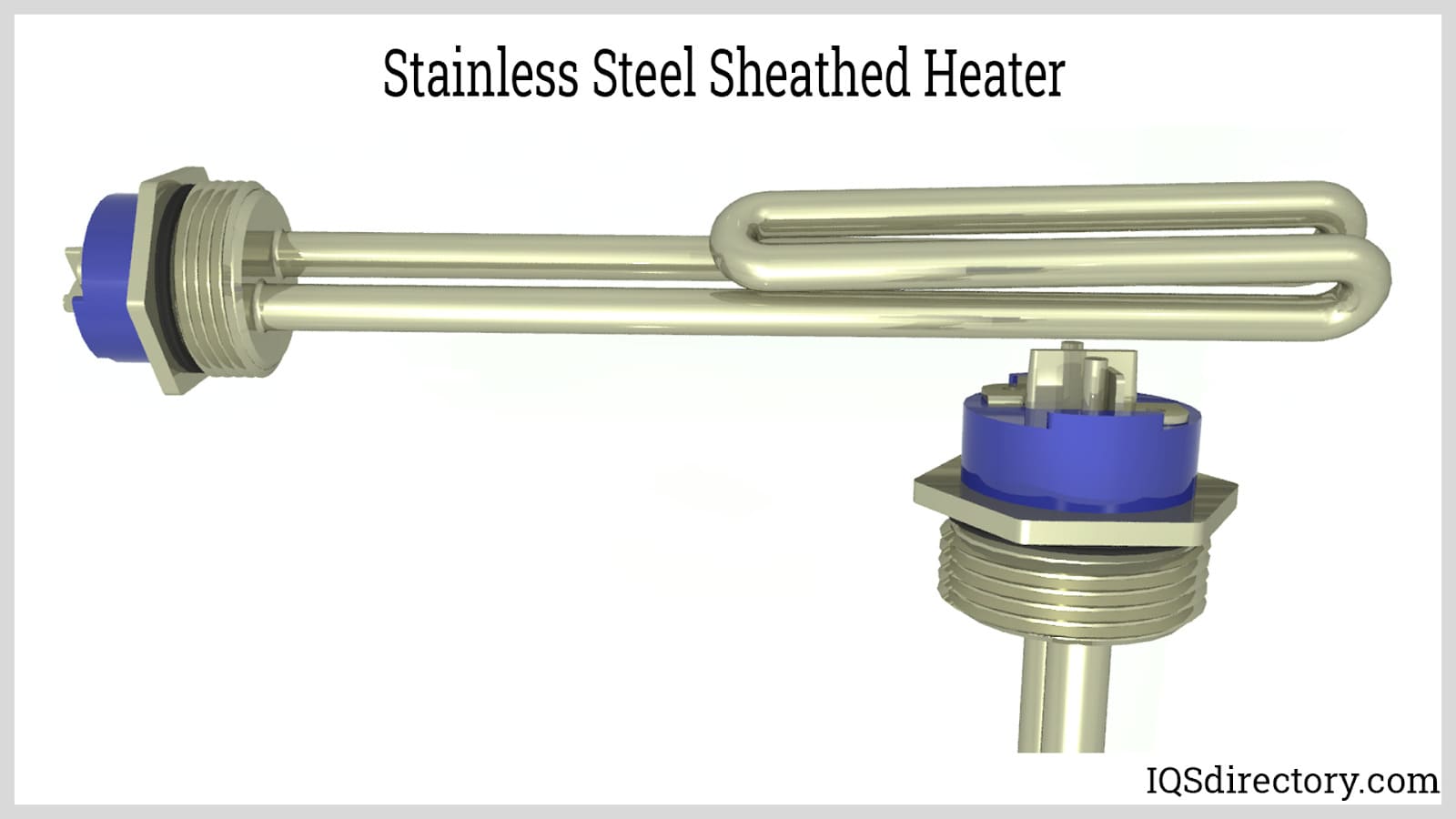
Conclusion:
- A heating element is a material or device that directly converts electrical energy into heat or thermal energy through a principle known as Joule heating.
- The most important heating element characteristics are sufficient resistivity, high oxidation resistance, low-temperature coefficient of resistance, high toughness, and high melting point.
- Widely used heating elements are nickel-chromium alloy, iron-chromium-aluminum alloy, molybdenum disilicide, and silicon carbide. These are followed by graphite and other refractory metals which generally have higher oxidation rates.
- Aside from the heating element, a heater consists of the terminations, leads, insulation, packing, sheath, and seals. These heaters have various forms and configurations to suit a particular application.
- Typical heater ordering specifications are the power or wattage, maximum operating temperature, type of process fluid, sheath material, and power supply (voltage and frequency).
Leading Manufacturers and Suppliers
GET YOUR COMPANY LISTED ABOVE















![Toni Kroos là ai? [ sự thật về tiểu sử đầy đủ Toni Kroos ]](https://evbn.org/wp-content/uploads/New-Project-6635-1671934592.jpg)


